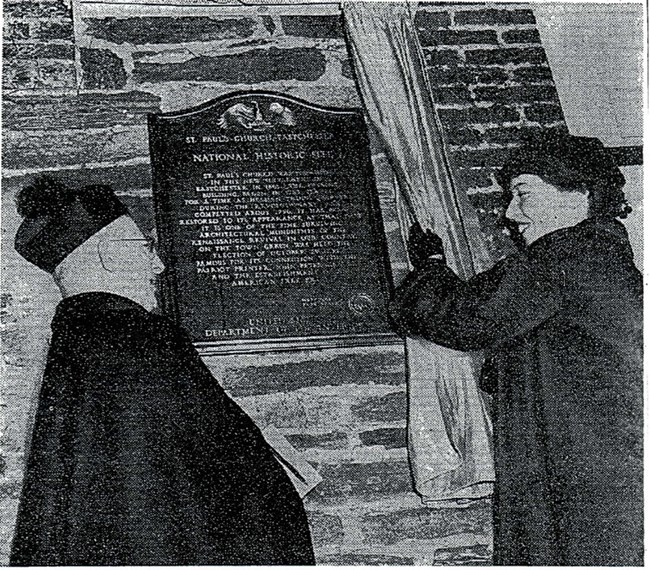Last updated: January 13, 2022
Article
Bronze Plaque Installed in 1952 Commemorates Designation of St. Paul’s as a National Historic Site

Bronze Plaque Installed in 1952 Commemorates Designation of St. Paul’s as a National Historic Site
A plaque affixed to the exterior of St. Paul’s registers the church’s designation as a national historic site, and also illuminates the importance in the mid-20th century of the freedoms of the Bill of Rights that were commemorated through the site’s historic significance.
St. Paul’s was still a functioning Protestant Episcopal Church in Mt. Vernon, New York when the small, rectangular bronze plaque was unveiled on December 15, 1952, recognizing the anniversary of the adoption of the Bill of Rights in 1791. The tablet features the seal of the National Park Service, United States Department of the Interior, although St. Paul’s did not become a unit of the Park Service until thirty years later. Places designated as national historic sites received explanatory markers even if ownership remained in private hands. St. Paul’s had been declared a national historic site in 1942.
The 26” x 20” plaque highlighting the Eagle symbol of America was unwrapped by the Rev. Howard D. Perkins and Ms. Zoo Zenger Boden, a direct descendant of John Peter Zenger, printer of the New York Weekly Journal in the 1730s. The date of the event and Ms. Boden’s participation in the ceremony underscored the historical importance attached to the church at the time, which is reflected in the copy on the curve-top tablet.
The historical importance focuses on a landmark, open air election held on the village green at St. Paul’s on October 29, 1733, which was chronicled in the inaugural issue of the Journal a week later. It is one of the earliest surviving accounts of the political lives of the colonists, capturing in previously unrecorded detail the ritual of early American elections, the issues that animated their public discourse and the process of religious discrimination in the 18th century.
The account was written by an eyewitness supporter of the victorious candidate Lewis Morris, an opponent of the high-handed Royal Governor of New York, William Cosby. The multi-paragraph highly descriptive dispatch exposed the chicanery of the sheriff supervising the canvass, who employed a religious litmus test to exclude Quakers who supported Morris. A subsequent interpretation of the election -- that is reflected in the plaque copy -- argued that the coverage of the polling led directly to the celebrated trial and acquittal of the paper’s printer John Zenger; and, as a consequence to the origins of freedom of the press enshrined in the first amendment to the Bill of Rights. That analysis was heralded by Rev. Harold Weigle, the St. Paul’s rector from 1929-1949, and advanced by some contemporary writers.
That understanding has been cited as an exaggeration by qualified historians, who interpret the historic importance of the canvass in terms of a landmark in the development of freedom of religion. As a result of the documented discrimination at the election, the Quakers in 1734 were granted freedom of conscience in future votes -- allowed to affirm, rather than compelled to swear. Those historians also emphasize the vivid report of one of the earliest examples of Americans resolving their disputes through elections.
On a cold December day, the well-attended ceremony attracted about 200 bundled-up people to the church, which annually held public programs on the Dec. 15 anniversary of the adoption of the Bill of Rights. In addition to the parish, local citizens committees joined in the commemoration, and Mt. Vernon supported the event as a cornerstone of their recognition of Bill of Rights Day. The discourses and press coverage of the ceremony and designation reflected the importance attached to the Bill of Rights at the time, the period of the Cold War, the American confrontation with the Soviet Union. This global political conflict was particularly resonant in 1952 while the Korean War raged in Asia, and the Bill of Rights was proclaimed as a valued expression of American freedom in comparison with Soviet communism.
While the tablet’s emphasis is clearly on the freedom of the press through the election of 1733, the raised letters on the bronze plaque record other elements of the St. Paul’s narrative. These include the Revolutionary War use of the edifice as a field hospital by the Hessians, German auxiliary allies of the British, although it omits the use of the church as an American hospital. Internal and external architectural features of the building are also referenced.
The full text reads:
St. Paul’s Church, Eastchester National Historic Site St. Paul’s Church Was Founded In The New Settlement Of Eastchester, In 1665. The Present Building, Begun In 1763, Served For A Time As Hessian Troop Quarters During The Revolutionary War. Completed In 1790, It Has Been Restored To Its Appearance At That Date. It Is One Of The Fine Surviving Architectural Monuments Of The Renaissance Revival In Our Country. On The Town Green Was Held The Election Of October 29, 1733. Famous For Its Connection With The Patriot Printer John Peter Zenger, And The Establishment Of An American Free Press.
National Park Service
United States Department of the Interior
